Document Price Escalation
Document Price Escalation simplifies the setup and processing of escalations and provides a mechanism to enable escalations on Meter Agreements, Site Agreements and Recurring Jobs.
The purpose of creating a price escalation is to allow a document to have its pricing automatically escalate at a pre-specified point in time.
At this time, Price Escalations can be setup on the following document types only - Site Agreements, Meter Agreements and Recurring Jobs.
Standard Jobs and Sales Orders can still have their pricing (or costs) adjusted using the Adjust Pricing program, but these document types cannot have automatic escalations pre-specified in advance.
Price Escalation Setup
Price Escalation Class Type
The Price Escalation Class Type is used to categorize escalation documents.
For example, if a Class Type is created called CPI (Consumer Price Index), all documents using the class type CPI can be updated with the latest CPI figure when available without having to go into each document individually to reset CPI to the current value.
Another example might be Platinum, Gold, Silver Service Level Agreements could all have different escalation percentages.
The Escalation Class Type can be used to default settings when a particular Escalation Class Type is selected.
Defaults can be manually modified and overridden at document level.
If the Class Type is left blank fields must be set manually when adding escalation parameters.
Document Price Escalation
Price Escalations can be set in Site Agreements, Meter Agreements, and Recurring Documents only at this time.
Standard Jobs and Sales Orders can still have their pricing (or costs) adjusted using the “Adjust Pricing” program, but these document types cannot have automatic escalations pre-specified in advance.
Select a Site Agreement, Meter Agreement or Recurring Job. For this example we will apply the Price Escalation to a Site Agreement.
A new tab Price Escalation will appear on the right of screen.
Click the Price Escalation tab.
Select the “Apply Price Escalation To” drop down to determine what type of lines to apply the price escalation to.
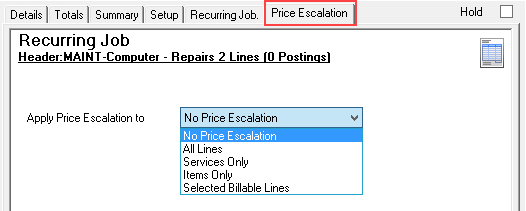
Additional fields will appear as follows once a line method has been selected.
•All Lines - Will apply the Price Adjustment to every Service and Item line in the Document
•Services Only - The Price Adjustment will only be applied to Service Lines in the Document
•Items Only - The Price Adjustment will only be applied to Item Lines in the Document
•Selected Billable Lines - The Price Adjustment will only apply to Service or Items lines in the Document with have the Apply Price Escl Check box ticked in their properties.
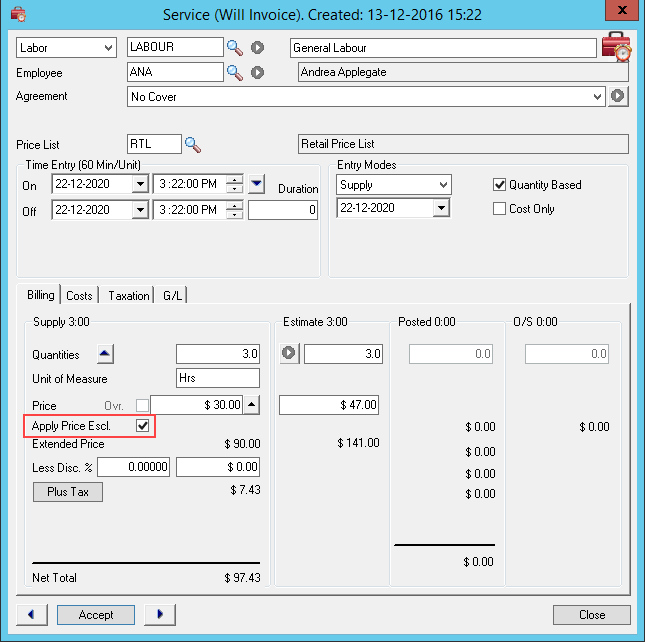
Select an Escalation Class Type to default settings from Class Type setup.
Escalation categories can be used to categorize documents. The benefit of categorizing documents is that multiple documents of the same category can be updated by changing a Class Type value. For example, if the CPI rate changes all documents that have a CPI uplift can inherit that change
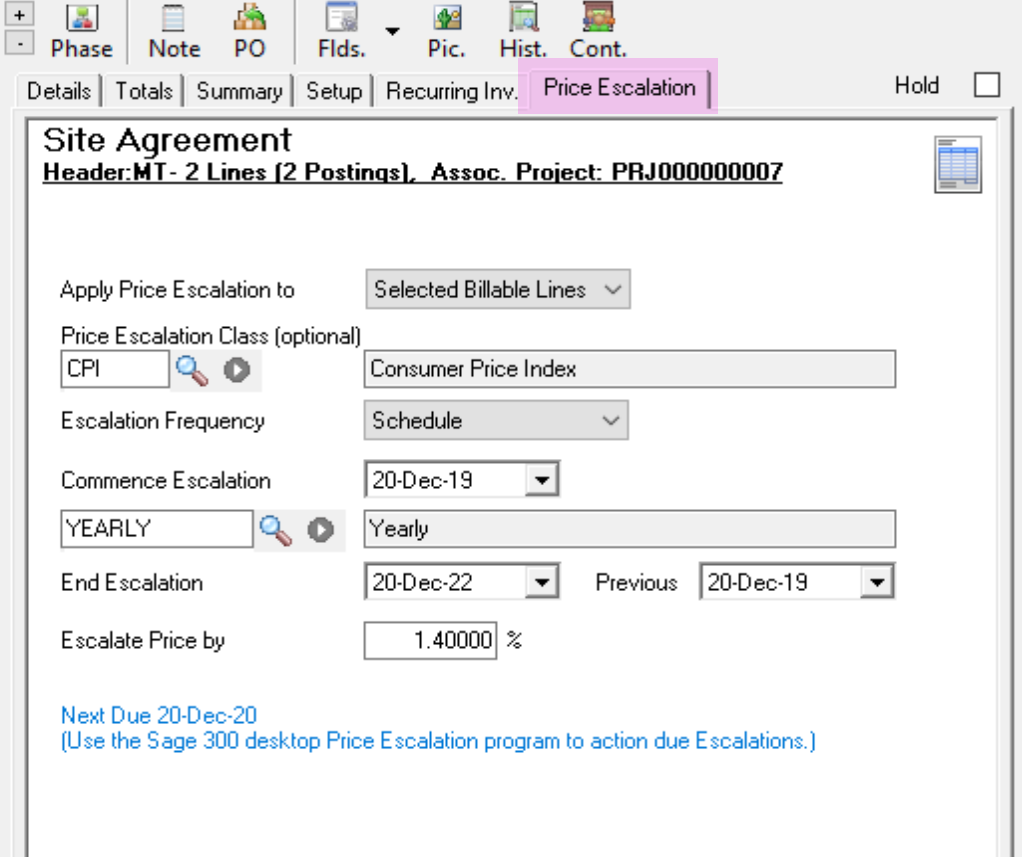
Posting Count Escalation Frequency Option
The Posting Count frequency option is one of two methods used to determine when to trigger the next escalation of a document. This method is applicable for Site Agreements, where Invoices are generated through Posting Schedules, and Recurring Jobs, where Jobs are generated through Posting Schedules. It is not available for Meter Agreements as Posting Schedules are not applicable for that document type.
When the Posting of a Scheduled invoice occurs the Current Count is increased with each invoice posted.
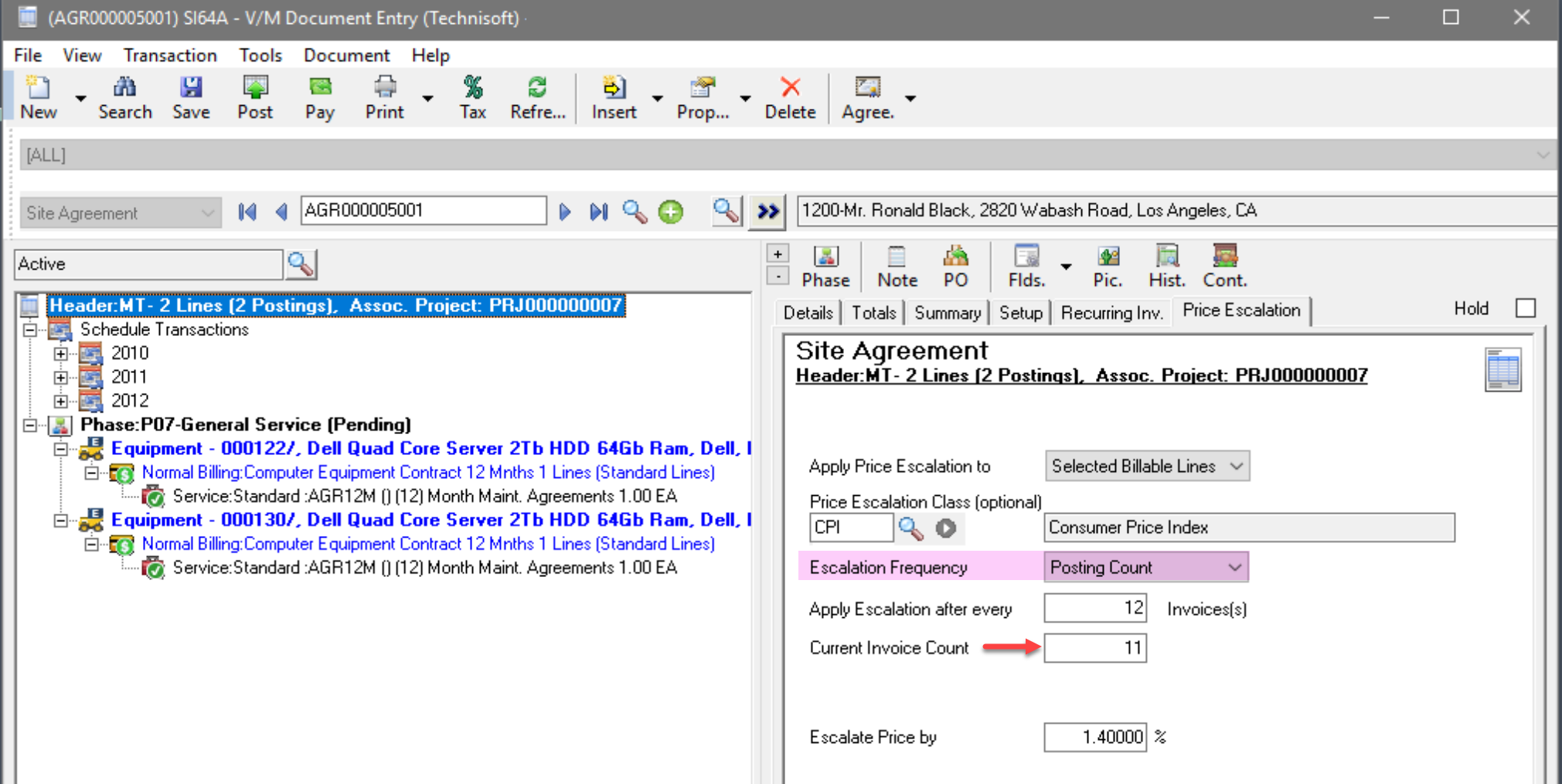
Once the “Current Invoice Count” is equal to or greater than the “Apply Escalation after every [X] Invoice/s” count, the invoice line is highlighted and the escalation occurs after the next invoice has been posted using the Posting Schedules program.
The Price Adjustment will be applied with that posting and then the next invoice subsequent to that will process at the adjusted price.
For example, if billing monthly and “Apply Escalation after every [12] Invoices” is set, the escalation will occur after the 12th invoice (yearly) has been posted. The 13th invoice will then have the new pricing (i.e. not the 12th invoice).
The benefit of using the Posting Count option as the frequency method is that it is automated so that once the invoice count reaches the “Apply Escalation after every [X] invoice/s” the escalation occurs automatically when the next Posting Schedule invoice is processed.
The current cycle count is reset after the threshold is reached, and the count begins again. i.e. Apply Escalation after every… will never equal the Current Count. Once it is equal the escalation is actioned and the Current Count is reset to zero (0) for the next escalation.
In the example below the Selected Billing Line, Labor Install had 5% increase applied to the Unit Price after the 12th Posting Schedule Invoice was processed.
The next invoice therefore will be at the new rate.
Not the original estimate price was $75, after escalation the price was increased by 5% to $78.75.

The Escalate Price by [X] % will default from the Escalation Class type selected. It can be overridden by typing in a value.
Entering a negative value in this field will apply a Unit Price Adjustment to decrease the applicable lines by the percentage amount specified
To terminate an escalation using the Posting Count Escalation Frequency method, simply set the “Apply Price Escalation to” field to “No Price Escalation”.
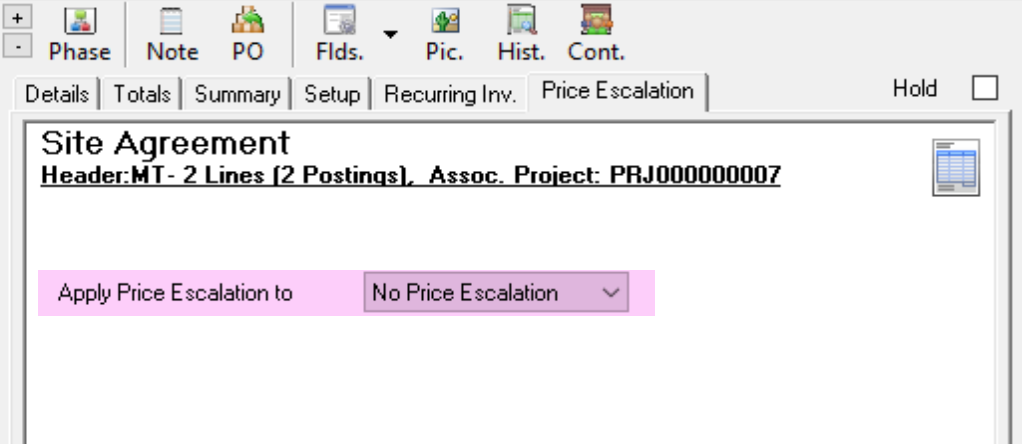
Note:
The Posting Count escalation frequency option is an automatic process. i.e. there is no requirement for the person processing the escalation to remember to action it. It will be automatically processed when the Posting Schedules program is run and the relevant “Apply Escalation after every [X] invoice/s count threshold is reached and triggered.
Schedule Escalation Frequency Option
The Schedule method of escalating pricing is the second of two methods used to determine when to trigger the next price escalation on a document.
This option was added so that price escalation could be configured for Meter Agreement Documents as Meter Agreements generally have no Term dates specified. This method is available to Site Agreements and Recurring Jobs as well.
Select “Escalation Frequency” = Schedule
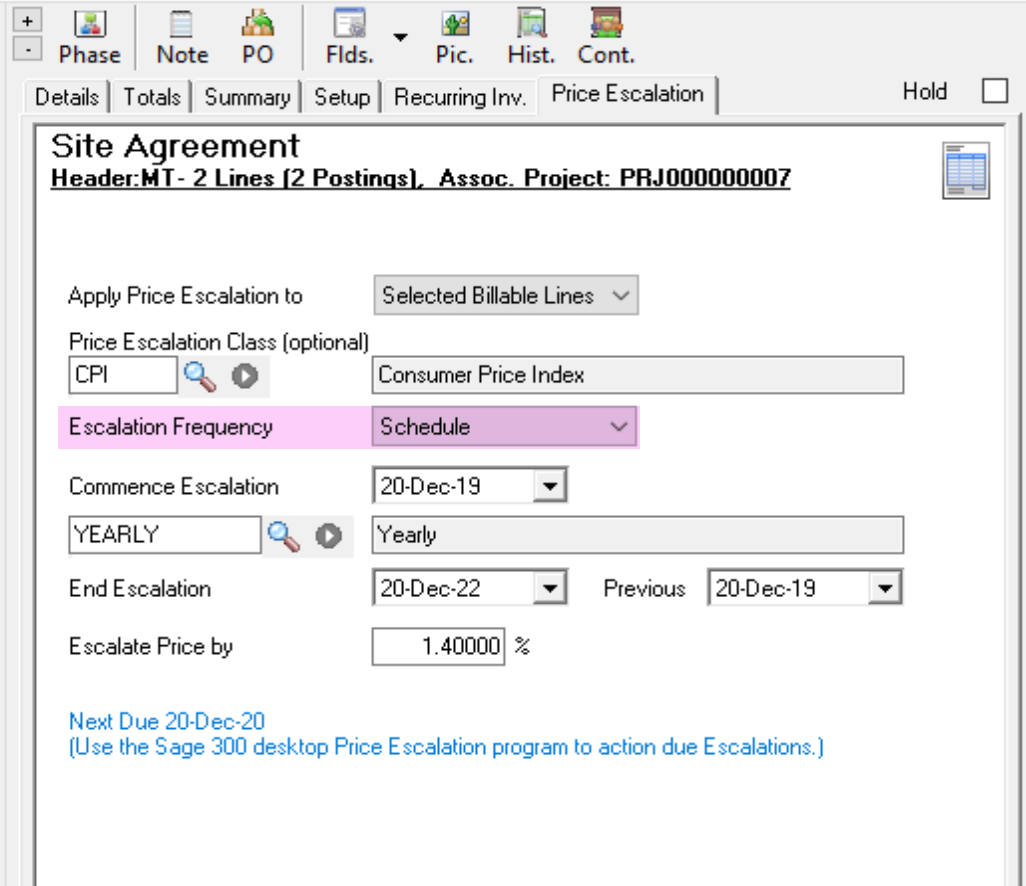
The Commence Escalation date is the start date to process the first escalation.
That is pricing will be escalated on that date, that does not mean the next invoice will process on that date.
Select a schedule to specify when to process subsequent escalations. E.g. a “Yearly” schedule would process the next escalation every 12 months.
Note:
The “Schedule” method of escalating pricing is not an automatic function like the Posting Count method is.
To post an escalation based on the “Schedule” method, use the new Price Escalation Program (see below - V/M Documents).
The Price Escalation program will display what documents are due for escalation. These can be checked before processing and then posted to affect the escalation. This only escalates the pricing it does not post an invoice. Invoice posting should still be processed using the “Posting Schedules” program.
In effect the Price Escalation program is a demarcation point that allows the checking of all documents before they are due to escalate.
The End Escalation Date is the date that escalations will not occur beyond. This date is not an escalation point itself, it just means that no further escalations will occur beyond the End date specified.
If the “Apply Price Escalation to” is set to “No price escalation”, that will also terminate the escalation but if using the Schedule that is not really necessary and the price escalation will auto terminate after the End Escalation date is reached.
The Escalate Price by [X] % will default from the Escalation Class type selected. It can be overridden by typing in a value.
Entering a negative value in this field will apply a Unit Price Adjustment to decrease the applicable lines by the percentage amount specified
Posting with Price Escalation Option of Specified Frequency Schedule
Escalations by Specified Frequency Schedule are posted through a the Price Escalation Program and not through the agreement or recurring job itself.
